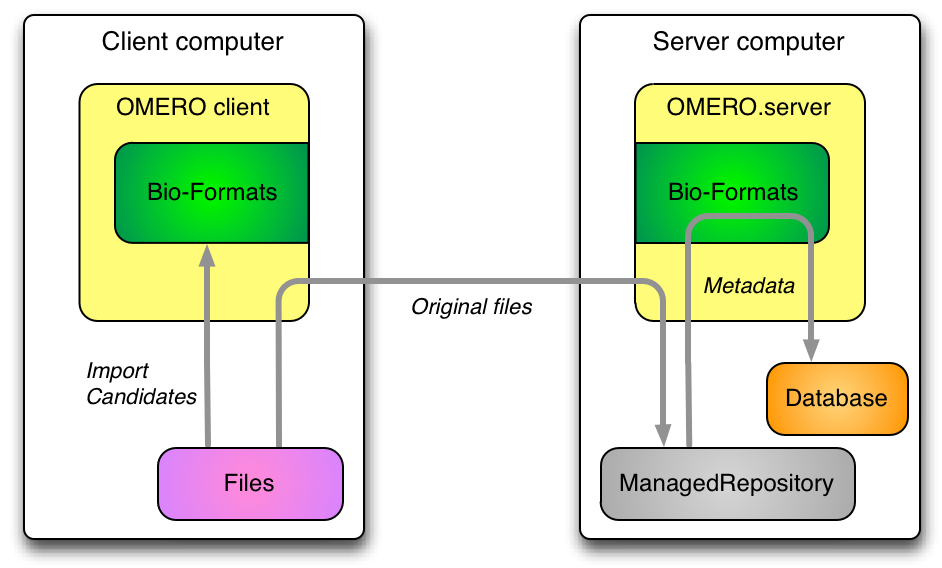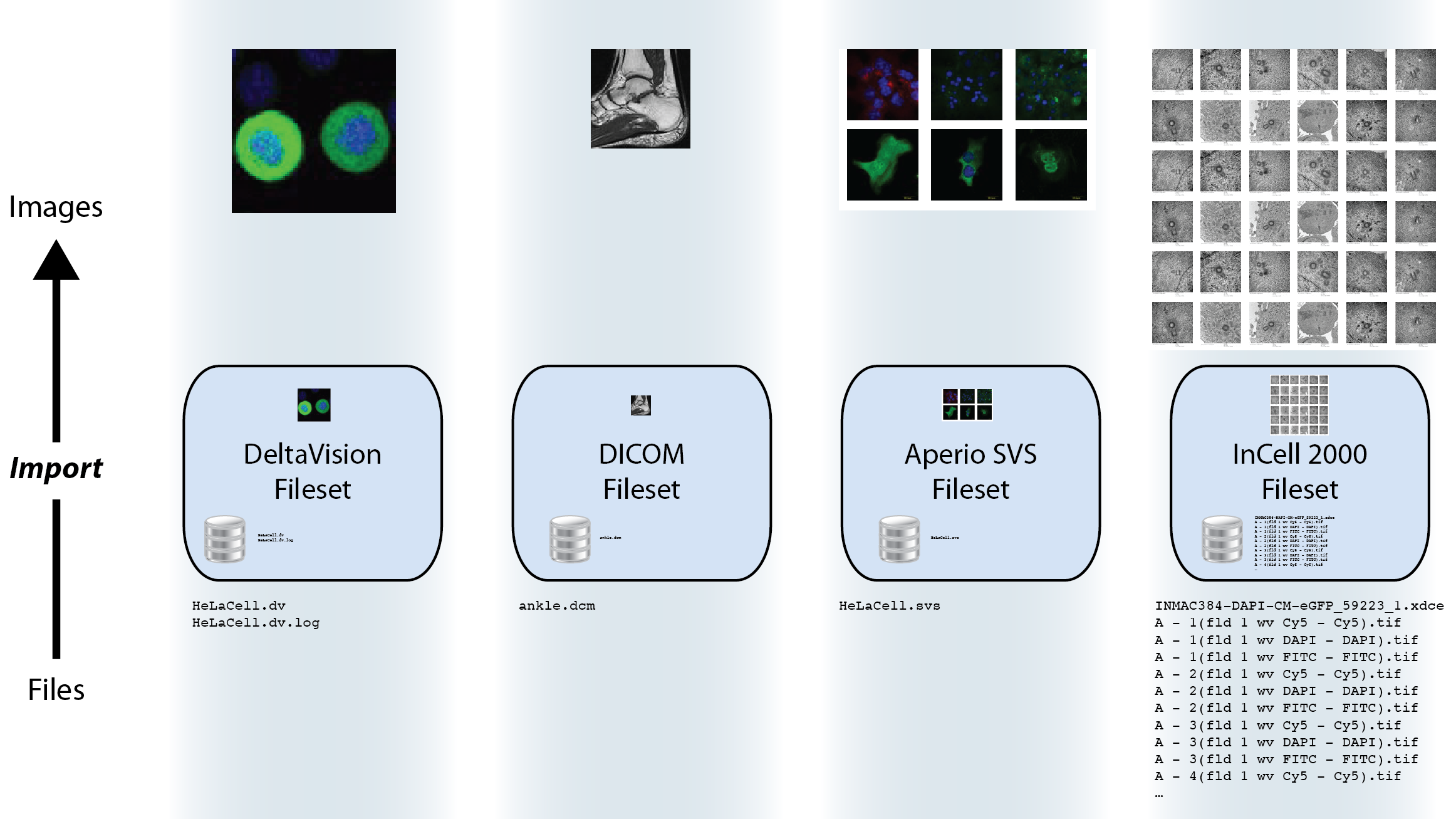Import under OMERO.fs
The OMERO 5 release introduces OMERO.fs, a new way of storing files in the OMERO binary repository and thus a new method of importing images to the server.
In previous versions of OMERO the import process was very much client-centered. When importing an image the client pushed pixel data, metadata and, optionally, original image files to the OMERO server. With the advent of OMERO 5, OMERO.fs allows the pixels to be accessed directly from the original image files. This means that much of the import process can now take place on the server once the original image files have been uploaded.
This page looks at the implications for the developer writing import clients. A broad description of the import workflow is followed by some of the model changes needed to facilitate this workflow. The current API sequence is then introduced before looking at server-side classes and sequence. Finally, the configuration required for OMERO.fs is specified.
Import overview

The broad import workflow comprises selecting a file or set of files to be
imported client-side. Using Bio-Formats on the client this selection is
resolved into a number of import candidates. Here an import candidate is a
file or set of files that represents a single image, a multi-image set or a
plate. Each import candidate, which may be one file or several files, is then
treated as Fileset for import. The import of each Fileset is then
undertaken by the client in two stages: upload and server-side import.
A Fileset is uploaded to the server into a location determined by the
server, multiple Filesets may be uploaded in parallel by a client. A
checksum is calculated before upload by the client and after upload by the
server. If these checksums match then the client triggers a server-side
import. The client can then move on to doing other work and leave the import
to complete on the server.
Once the Fileset is on the server and an import has been initiated by the
client all processing then takes place on the server. The server then uses
Bio-Formats to extract and store the metadata, calculate the minimum and
maximum pixel values and do other import processing.
Filesets
A fileset is a concept new to OMERO.fs which captures how
Bio-Formats relates files to the images that they encode. If
importing a single file leads to a single corresponding image being viewable
then a one-to-one mapping exists from file to image. However, an image’s
information may be split among multiple files, or a single file may encode
multiple images. In other cases, especially in high-content screening, many
images of wells may be encoded in a complex manner by many files. In all these
cases, a fileset is used to hold the set of files and the set of images to
which those files correspond.

Filesets are essentially indivisible: the files or images that a fileset represents are deleted, or moved between groups, only as one unit together, and on the server each fileset has a directory in which only its files are stored. Each fileset firmly binds sets of files and images because the dependencies among them mean that splitting components away leaves a partial fileset making the remaining data unreadable. Similarly, you should not rename any components of a fileset as this will also break the dependencies holding them together.
Model description
See acquisition.ome.xml.
ome.model.fs.FilesetRepresents a group of files which are considered to belong together.
In the future the client may upload a single “import set” that is subsequently resolved by Bio-Formats into multiple filesets on the server.
Also links to multiple ome.model.jobs.Job instances.
Links to the image objects that are created during import.
ome.model.jobs.JobsubclassesEach one represents some action which takes place server-side on the Fileset.
For the standard sequence described above, the first will always be an
UploadJobwhich contains version info from the client. If the files were not uploaded however, this may not be the case. Then aMetadataImportJobfollows, which is the basic import.Other jobs may be necessary for regular usage (
PixelDataJob,IndexingJob, etc.). Later jobs may also be added like a re-parse job, a re-check of the hashes to detect corruption, or an archive job.For job definitions, see jobs.ome.xml.
Some subclasses have a
versionInfoproperty for storing a snapshot of process information along with software versions. Most important for knowing how files were parsed, therefore when usingimportPaths, a “synthetic” version info might be created to say that these were just uploaded blindly.
ome.model.fs.FilesetEntryLink from a
Filesetto exactly oneome.model.core.OriginalFileCritically, it also contains the original absolute client path of that file.
API sequence
Choose which files to import by either:
ImportLibraryand friends (Java only)listing all files (not directories) manually.
Choose a
ManagedRepositoryPrxfromSharedResourcesPrx.repositories().Call either:
ImportLibrary.importImage()which callsManagedRepositoryPrx.importFilesets(Fileset, ImportSettings), ordirectly use
ManagedRepositoryPrx.importPaths(StringSet).
Receive an
ImportProcessPrx.For each
FileEntryin theFileSetor each path in theStringSet(in order), callImportProcessPrx.getUploader()and receive aRawFileStorePrx.Upload the file via
RawFileStorePrx.write()while reading the files locally to write, be sure to calculate the checksum.Pass a list of checksums (in order) to
ImportProcessPrx.verifyUpload(StringSet). If the hashes match, receive aHandlePrx. Otherwise an exception is thrown.
At this point, the client should be able to disconnect and the rest of the import should happen independently.
Create an
CmdCallbackIthat wraps theHandlePrxand wait for successful completion.
At this point, the main metadata import is finished, but background processing may still be occurring. Handles for the background processing will also be returned.
Server-side classes/concepts
AbstractRepositoryI and all of its subclasses are implementations of the
InternalRepository API. These objects are for internal use only and should
never be accessible by the clients. Each instance is initialized with a
directory which the servant attempts to “acquire” (i.e. grab a lock file).
Once it does so, it is the serving repository.
Each internal repository provides a public view which in turn provides the
Repository API. All method calls assume Unix-style strings, which are
guaranteed by CheckedPath, a loose wrapper around java.io.File.
CheckedPath objects along with the active Ice.Current instance are passed
to the RepositoryDao interface, which provides database access for all
repositories. Access to raw IO is provided by the RepoRawFileStoreI
servant, which wraps a RawFileBean.
The ManagedRepository implementation is responsible for import and
enforces further constraints (beyond those of CheckedPath) on where and what
files are created. Most importantly, the omero.fs.repo.path template
value is expanded and pre-pended to all uploads. A further responsibility of
the ManagedRepository is to maintain a list of all currently running
ManagedImportProcessI, each of which is held in the ProcessContainer.
These ManagedImportProcessI instances further wrap RepoRawFileStoreI
instances with a subclass, ManagedRawFileStoreI.
For file import through ManagedRepository.importFileset, although hasher is
nullable ordinarily, it will be set through the mandatory
ImportSettings.checksumAlgorithm property.
ManagedRepository.listChecksumAlgorithms lists the hashers supported by the
server. ManagedRepository.suggestChecksumAlgorithm helps the client and
server to negotiate a mutually acceptable algorithm, as in
ImportLibrary.createImport; the result is affected by the server’s
configuration setting for omero.checksum.supported. ImportLibrary
calculates each file’s hash using hashers obtained through
ChecksumProviderFactory.getProvider. In fetching OriginalFile objects by HQL
through the Query Service one needs JOIN FETCH on the hasher property to
read the hasher’s name.
Server-side sequence
NB: Server-side ImportLibrary is no longer being used. That logic is
currently moved to ManagedImportRequestI. This may not be the best
location. Further, several other layers might also be collapsible, like
OMEROMetadataStore which is currently accessible as a “hidden”
service MetadataStorePrx. Here, “hidden” means that it is not
directly retrievable from ServiceFactoryPrx.
ManagedRepositoryI.importPaths()reuses
ImportContainer.fillData()to create anImportSettingsand aFilesetand then callsimportFileset(Fileset, ImportSettings)
ManagedRepositoryI.importFileset()determines an
ImportLocationcallingPublicRepositoryI.makeDir()where necessary.createImportProcesscreates aManagedImportProcessI, registers it, and returns it.After this, the repository is only responsible for periodically having the ping and eventually the shutdown method called, via
ProcessContainer.
ManagedImportProcessI.getUploader()creates a new
RepositoryRawFileStoreIfor each file in the paths/fileset.Once
close()is called on this instance,closeCalled(int i)will be called on the import process and the instance will be removed.If
getUploader()is called again, then a new file store will be created.
ManagedImportProcessI.verifyUpload()If all hashes match, then a
ManagedImportRequestIinstance is created and submitted toomero.cmd.SessionI.submit_async()for background processing. The client can wait for the returnedomero.cmd.HandlePrxto finish by using aCmdCallbackI.At this point, the
ImportProcessPrxcan be closed as well as the entire client and the import would still continue. Only ifHandlePrx.cancel()is called, will the import be aborted.QUESTION: How to handle rollback at this point?
ManagedImportRequestI.init(within transaction)Registry.getInternalServiceFactory()grabs aServiceFactoryPrxwithout the need for anomero.clientinstance.OMEROWrapperand aOMEROMetadataStoreClientare created with this connection.Some other basic configuration takes place.
ManagedImportRequest.step()(N times, each within same transaction asinit())NB: it may later make more sense for this bit to happen in a separate process.
At the moment, 5 steps are hard-coded. Each performing roughly the same amount of work. Some of these may later be done in the background.
importMetadata()callsstore.saveToDB(), which callsMetadataStorePrx.saveToDb(), a remote call. This could possibly be inlined.generateThumbnails()callsstore.resetDefaultsAndGenerateThumbnails(), another remote call, which could also be inlined.pixelData()callsstore.setPixelsParams(),updatePixels(), andpopulateMinMax(). Min/Max especially should be backgrounded.Finally,
store.launchProcessing()is called, which should remain, but could also be inlined. The returned script processes could be returned in theImportResponse.Return appropriate values.
notifyObservers()currently does nothing, since this was client-side functionality inImportLibrary. This needs to be replaced!
ManagedImportRequest.buildResponse()(N times, outside the transaction)Only step 4 does anything, storing the pixels in a
ImportResponse
ManagedImportRequest.getResponse()(1 time, regardless of exception or not)Performs cleanup, then returns the
ImportResponseassuming that no call tohelper.cancel()has been made. At this point,ImportLibrary.importImage()returns successfully.